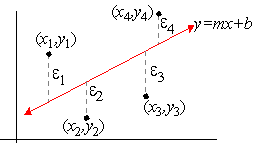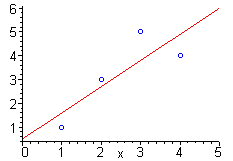Linear Systems and Quadratic Extrema
Many applications involve quadratic functions, where a
quadratic function is a function that is a second degree polynomial in each
variable. When a quadratic function has a critical point, it must be the
solution to a system of simultaneous linear equations (also known as a
linear system) of the form
One way of solving a linear system is to multiply the first equation by
-c, multiply the second equation by
a, and
combine the two equations to eliminate x:
| -acx - bcy |
= |
-r c |
| acx + ady |
= |
s a |
 |
 |
 |
|
( ad-bc) y |
= |
sa-rc |
|
After solving for y, substitution can be used to determine x.
Or any of a number of other variations may be used instead.
EXAMPLE 4 Find the point(s) on the plane z = x+y-3 that are
closest to the origin.
Solution: To begin with, we let f denote the square of
the distance from a point ( x,y,z) to the origin.
Consequently,
Substituting z = x+y-3 thus yields
|
f( x,y) = x2 + y2 + (x+y-3)2 |
|
Since fx = 4x+2y-6 and fy = 2x+4y-6, we must solve
Multiplying the second equation by -2 yields
so that y = 1. Similarly, we find that x = 1, so the critical point is ( 1,1) . Moreover, fxx = 4, fxy = 2, and fyy = 4, so
that the discriminant is
|
D = fxx fyy - fxy2 = 16 - 4 = 12 > 0 |
|
Thus, every "slice'' is concave up and correspondingly, f has a minimum
at ( 1,1) . Substitution yields
so that ( 1,1,-1) is the point in the plane z = x+y-3 that is
closest to the origin.
One of the most important applications in statistics is finding
the equation of the line that best fits a data set of the form
|
( x1,y1) ,( x2,y2) ,¼,(xn,yn) |
|
where by best fit we mean the line which produces the least error.
Specifically, the jth error or residual in approximating
the data set with the line y = mx+b is
Thus, ej2 is the square of the vertical distance from the
point to the line.

We then define the least squares line for the data set to be the line
with the slope m and the y-intercept b that minimizes the total
squared error
|
E( m,b) = |
n
å
j = 1
|
( mxj+b-yj) 2 |
|
That is, the least squares line minimizes the sum of the squares of the
residuals.
EXAMPLE 6 Find the least squares line for the data set (1,1), ( 2,3), ( 3,5), and (4,4) .
Solution: To find E( m,b) , we calculate the squares
of the residuals for each of the data points and then compute their sum:
The first partial derivative of E( m,b) are
|
Em( m,b) = 60m+20b-76 and Eb( m,b) = 20m+8b-26 |
|
Thus, the critical points must satisfy
Multiplying the latter by -3 yields
|
60m + 20b |
= |
76 |
| -60m - 24b |
= |
-78 |
| 0m - 4b |
= |
-2 |
|
Thus, b = 0.5 and likewise, we find that m = 1.1.
The second derivatives of E( m,b) are
|
Emm = 60, Emb = 20, Ebb = 8 |
|
and as a result, the discriminant is
|
D = 60·8-( 20) 2 = 80 > 0 |
|
which implies that E( m,b) has a minimum at m = 1.1 and b = 0.5. Thus, the least squares line for the data set ( 1,1) , ( 2,3) , ( 3,5) , and ( 1,4) is y = 1.1x+0.5:

Typically, due to the size of the data sets involved, least squares problems are
not solved by hand. Correspondingly, our investigation of least squares
problem is treated with greater depth and more examples in the associated
Maple worksheet.
Check your reading: Why did we use the square of the distance
instead of the actual distance in example 4?

